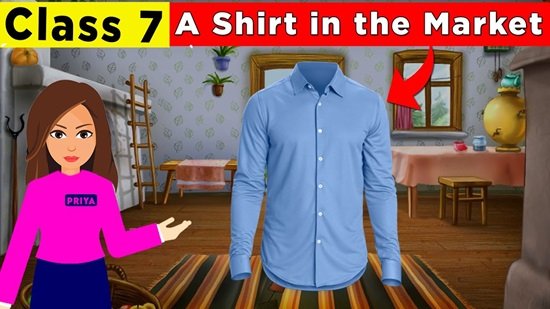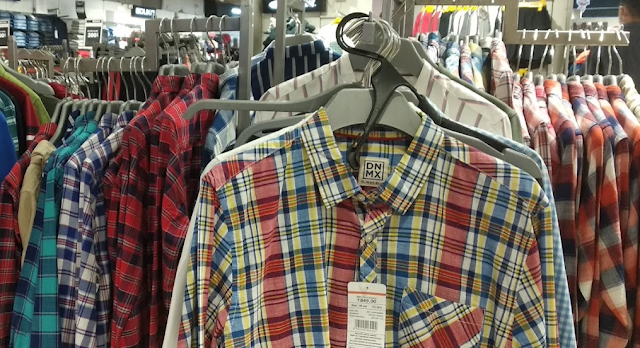
Chapter 8: A SHIRT IN THE MARKET ( Best Solution )
A SHIRT IN THE MARKET

A SHIRT IN THE MARKET:
A Shirt in the Market” is a chapter in the NCERT Class 7 Social Science textbook that explores the process of a shirt’s journey from production to consumption. The chapter uses a case study to illustrate how the market works, and to help students understand the roles of producers and consumers.
Life of a Cotton Farmer
The life of a cotton farmer is not easy. Many farmers who grow cotton have small farms and have to work hard to harvest the cotton crop. After harvesting the cotton, the farmers generally sell the cotton to the nearby traders. Some traders also provide loans to the farmers at very high interest rates. Also, while providing the loans, they sometimes put forth the condition before the farmers that they would sell their cotton produce only to them. The farmers are thus forced to sell their cotton to the same trader, who gives them a minimum price for their produce. This results in the exploitation and poverty of the cotton farmers.
Role of Weavers in the Production of Cloth
- Merchants give work to the weavers depending on the type of order they receive for making a cloth.
- The weavers generally get yarn from the merchants. This is beneficial to the weavers as they do not have to spend their money on purchasing the yarn.
- Also they do not have to worry about selling the cloth made, as this responsibility is taken by the merchants. Weavers also know in advance the kind of the cloth they need to weave.
- This arrangement between a merchant and a weaver is known as the putting out system. In this system, the merchant provides the raw materials to the weavers and buys the finished products from them. This system is practiced in the weaving industries in many parts of the country.
- One negative aspect of the above arrangement between the merchants and the weavers is that it makes the merchants very powerful. They pay a very little amount to the weavers for weaving the cloth.
- The merchants then sell the cloth to garment factories and earn huge profits. In this way, the market favours the merchants more than it favours the weavers.
- The life of a weaver is not easy. Weavers buy looms for weaving cloth by borrowing money at a high rate of interest.
- Once the looms are purchased, they work along with their family members on the loom stretching up to twelve hours per day.
- Despite this, most weavers are able to earn only Rs. 3,500 per month through their work.
Role of Garment Factories: A SHIRT IN THE MARKET
- The cloth, woven by the weavers, is sold to the garment factories by the merchants at a high profit.
- The garment factory then makes shirts, dresses, saris and other kinds of clothing from the cloth.
- The garment factories either sell these finished products to shops in various parts of the country or export the cloth to foreign countries.
- The foreign buyers are generally large stores who do business strictly on their own terms. They purchase the finished cloth at very cheap rates. Besides, they purchase products of high quality and expect the products to be delivered at the given time.
- The suppliers try their best to meet the demands of these store houses.
- Garment factory owners try to reduce the cost of production in order to maximise their profits.
- This is done by hiring workers at extremely low wages.
- Mostly, workers in the textile industry work the maximum at the lowest possible wages.
- Workers have no job security as they can be asked to leave during lean period.
- Women are generally employed for thread cutting, buttoning, ironing and packaging and are paid minimum wages.
Gainers in the Markets:A SHIRT IN THE MARKET
Purchasing and selling of cloth takes place at every step in the market. The gainers in this market are merchants and garment factories who make huge profits. The garment stores which sell their products at very high prices make the most profits. The cotton farmers and weavers who do the majority of the work suffer as they do not get paid according to the work they do.
Equality in the Markets
- In the textile market, garment exporters make moderate profits while garment stores and foreign businessmen make huge profits.
- The wages of the workers in the factories are so low that they are barely able to fulfill their day to day needs.
- Similarly the cotton farmers are also not able to earn enough to fulfill the daily needs of their family as they do not get a fair price of the cotton they sell in the market.
- Therefore, we see that everyone does not gain and earn equally in the markets.
- The growers and producers do not get just profits for their work while the rich and powerful earn maximum from the markets. Since these merchants have money, own land and shops, the poor sections of society depend upon them for various resources.
- Because the poor people are dependant on the rich sections of society, they are exploited by the rich.
- Hence laws should be framed to protect the interests of the farmers and the weavers.
- One such step is the formation of various cooperatives of producers to ensure that the laws are followed strictly.
Important Questions of A SHIRT IN THE MARKET
- Multiple Choice Questions :A SHIRT IN THE MARKET
Question 1. The Impex garment factory employs mostly:
(a) Women
(b) Men
(c) Children
Question 2. The workers in the garment factory work atleast:
(a) 1 to 3 hours
(b) 10 to 12 hours
(c) 6 hours
Question 3. Who links the producer of cotton to the buyer at the supermarket?
(a) A chain of market
(b) Only wholesalers
(c) None
Question 4. Small farmers are exploited by:
(a) Consumers
(b) Producers
(c) Big traders
Question 5. The one of the world’s biggest bi-weekly market of Erode is located in:
(a) Kerala
(b) Karnataka
(c) Tamil Nadu
Question 6. How a merchant distributes work among the weavers?
(a) Based on orders received
(b) Based on wages
(c) Based on ages
(d) None of these
Question 7. What do you think large farmers would sell their cotton?
(a) Weekly market
(b) Market
(c) Export
(d) Import
Question 8. Who sends the manufactured garments to other countries of the world?
(a) Exporter
(b) Importer
(c) Manufacturer
(d) Worker
Question 9. Who buys the bales of cotton to convert them into yarn?
(a) Ginning mill
(b) Spinning mill
(c) Cleaning mill
(d) Weaving mill
Question 10. What is linked in the chain of market?
(a) Producer and buyer
(b) Producer and retailer
(c) Producer and worker
(d) None of these
Question 11. Why do you think more women are employed in the Impex garment factory?
(a) They don’t take leave
(b) They agree to work at lowest wages
(c) They do finishing work
(d) None of these
Question 12. Why women are employed in garment factories?
(a) Buttoning
(b) Ironing
(c) Packaging
(d) All of the above
Question 13. How a merchant distributes work among the weavers?
(a) Based on orders received
(b) Based on wages
(c) Based on ages
(d) None of these
Question 14. Where can one-buy branded product from
(a) Wholesale market
(b) Neighbour shops
(c) Shopping complex
(d) Weekly market
Question 15. Which is the largest cloth market in the world?
(a) Tamil Nadu
(b) Delhi
(c) Ahmedabad
(d) Agra
- Fill in the blanks :
- Spinning is done by _______.
- Small farmers are exploited by _______.
- _______ is a factory where seeds are removed from cotton balls.
- The arrangement between the merchant and the weavers is termed as ________.
- _______ is the amount that is left or gained from earnings after deducting all the costs.
- Write true (T) or false (F) :
- The trader keeps an account of the yarn given and pays them money for weaving this into cloth.
- Most often, the big farmers need to borrow money to meet their expenses.
- The weavers and their families spend long hours working on the looms.
- Cultivation of cotton requires high levels of inputs such as fertilisers and pesticides.
- Very Short Questions :
- Why is a weekly market called so?
- Why is there a competition among the shops in the weekly market?
- Who is Scuneer? What does he do?
- Give some examples of roadside stalls.
- How are shops in the neighbourhood useful?
- Where are goods produced?
- Why do we not buy directly from the producer?
- Who is a retailer?
- Who is Aftab?
- How are buyers different people?
- Short Questions :
- Explain the conditions of employment as well as the wages of workers in the garment exporting factory.
- Differentiate between a large farmer and a small farmer.
- How garment exporting factories maximise their own profit?
- Merchants hold lot of power. Explain how
- In what way weavers dependent upon cloth merchants?
- Long Questions :
- Where do you think the large farmers would sell their cotton? How is their situation different from small and poor farmers?
- Write in brief about shopping complexes and malls.
- What is the job of a wholesale trader?
- How are shop owners in a weekly market and those in a shopping complex very different people?
- Write a brief note on ‘Aftab—the wholesaler in the city’.
ANSWER KEY –
- Multiple Choice Answer :
- (a) Women
- (b) 10 to 12 hours
- (a) A chain of market
- (c) Big traders
- (c) Tamil Nadu
- (a) Based on orders received
- (b) Market
- (a) Exporter
- (b) Spinning mill
- (a) Producer and buyer
- (b) They agree to work at lowest wages
- (d) All of the above
- (a) Based on orders received
- (c) Shopping complex
- (a) Tamil Nadu
- Fill in the blanks :
- cotton mill
- big traders
- Ginning mill
- putting-out system
- Profit
- Write true (T) or false (F) :
- True
- False
- True
- True
- Very Short Answer :
- A weekly market is called so because it is held in a specific day of the week.
- In the weekly market there are many shops that sell the same goods. This creates competition among them.
- Sameer is a small trader in the weekly market. He buys clothes from a large trader and sells them in six different markets in a week.
- Vegetable hawker, fruit vendor, mechanic.
- These types of shops are close to our home and we can go there any time. As the buyer and seller know each other these shops also provide goods on credit.
- Goods are produced in factories, on farms and in homes.
- It is because the producer is not interested in selling goods in small quantities.
- A retailer is a small trader who buy goods from the wholesale trader and sells this to the consumer.
- Aftab is a wholesaler in the city. He purchases vegetables in bulk and sells them to hawkers and shopkeepers.
- There are many buyers who cannot afford evan the cheapest of goods. While others frequently visit malls and buy different items.
- Short Answer :
- The conditions of employment and wages of workers in the garment factory can be described as mentioned below:
Conditions of employment – unhygienic conditions, no regular service, highly congested place, no job security, no proper arrangement of urinals / bathrooms / drinking water etc.
Wages – very low and unfair wages, no regular job, contract job, unfair deal.
- A Large farmers sell their crop to the crop market at higher prices. Their situation is quite different from poor and small farmer because a small poor farmer needs to borrow money for cultivation and at the other time of exigencies. They have to sell their crops to the traders as they took loan from them and had no bargaining power. Large farmers don’t depend on others for money to start cultivation.
- They maximise their own profits by getting maximum work from workers at lowest price and supply the foreign buyers at cheap rates.
- Weaver weaves clothes that have been made on order from the merchant. Merchant also provide them yarn to weave clothes.
- Weaver weaves clothes that have been made on order from the merchant. Merchant also provide them yarn to weave clothes.
- Long Answer :
-
- Large farmers would sell their cotton to the cotton market at higher prices. Their situation is quite different from poor and small farmer because unlike them, A small poor farmer needs to borrow money for cultivation and at the other time of exigencies. They have to sell cotton to the traders as they took loan from them and had no bargaining power. Large farmers don’t depend on others for money to start cultivation.
- Shopping complexes and malls are usually found in urban areas. These are large multi-storeyed air-conditioned buildings with shops on different floors. These shops sell both branded and non-branded goods. Fewer people visit malls because they sell costly items. Only well-to-do people can afford to buy these items.
- A wholesale trader buys goods from the producer in large quantities. He then sells them to other traders, say small traders. These small trader sell different items to the final consumer. Thus, the wholesale trader establishes link between the producer and the consumer. It is through these links of traders that goods reach faraway places.
- Both are undoubtedly different people:
- The shop owners in a weekly market are small traders who run their shop with little money. On the other hand the shop owners of a shopping complex are big parties. They have a lot of money to spend on their shops.
- What these two types of shop owners earn is also not equal. The weekly market trader earns little compared to the profit of a regular shop owner in a shopping complex.
- Aftab is a wholesaler of vegetables. His work usually starts around 2 o’clock in the early morning. This is the time when vegetables reach the market or mandi and with them start the activities. The vegetables come in trucks, matadors, etc. and soon the process of auctions begins. Aftab participates in this auction and decides what he will buy. He buys vegetables in bulk. After that he sells them to hawkers and shopkeepers who usually come to him around six in the morning.
Please Visit Readspot for Hindi Medium Study Material




1 Comment